Looking for some inspiration to help you take your repertoire of desserts to the next level? Then look no further! In this whistle-stop guide around every nation in Europe, we’ve uncovered some of the most delicious treats for you to try.
While some are based on traditional recipes dating back hundreds of years, others are more recent creations which have rapidly become part of the national cuisine. Some make spectacular centerpieces at celebrations, while others are simple snacks to be enjoyed any time. What they all have in common is their close association with the nation where they’re known and loved.
Do you agree with our choice for your country? Share your memories of the treat we’ve selected, or suggest alternatives for members of our community to try for themselves.
1. Albania: Flija

Flija is often referred to as a pie or cake, although it’s actually the name for a specific pattern of stacked pancakes. As with all traditional desserts, there are many versions of the basic recipe, but the ingredients are always simple.
The filling is usually made by blending oil, butter, yogurt, or kaymak. As the pancakes aren’t themselves sweet, they can be served with savory toppings, but as a dessert, jam or honey are the preferred accompaniments.
2. Andorra: Crema Andorrana (Catalana)
Given Andorra’s close ties to Spain, it’s no surprise that crema Catalan, called locally crema cremada or crema de Sant Josep, is one of the most commonly served desserts.
Flavorings such as lemon zest, cinnamon, and vanilla give each recipe its distinctive twist. Crema Catalan is topped with a glass crust of caramelized sugar which covers the smooth creamy treat waiting below.
3. Armenia

Gata is an Armenian pastry or sweet bread with a strong cultural and symbolic significance. Gata is easily considered one of the most popular Armenian desserts.
The origin of the gata is closely related to the establishment of the monastery in Armenia. The church founded by St. Gregory the Illuminator was built after Christianity was first adopted as the state religion.
4. Austria: Apfelstrudel

Austria is famous for its mouthwatering cakes and desserts, but perhaps apfelstrudel is the most iconic.
This dessert dates back to the 17th century, and it’s claimed that it was invented to please the Emperor of the time.
The dough can be filled with raisins, cinnamon, and nuts such as almonds, in addition to the soft apple. Best served warm, straight from the oven accompanied by whipped cream, ice cream, or vanilla custard.
5. Azerbaijan: Bamiyeh

Bamiyeh has a unique and exotic flavor and it one of the most popular desserts in Azerbaijan. The choux pastry used to make it is put through a meat grinder fitted with a special nozzle with a toothed hole in the center.
The result is a ribbed pasta dough, divided into equal portions, stretched to a length of 7-8 cm, and fried in vegetable oil. The bamiye is then submerged in sugar syrup until entirely saturated. Once dried, sugar is sprinkled over it. Then taste it – you’ll need someone to stop you!
6. Belarus: Kulaga
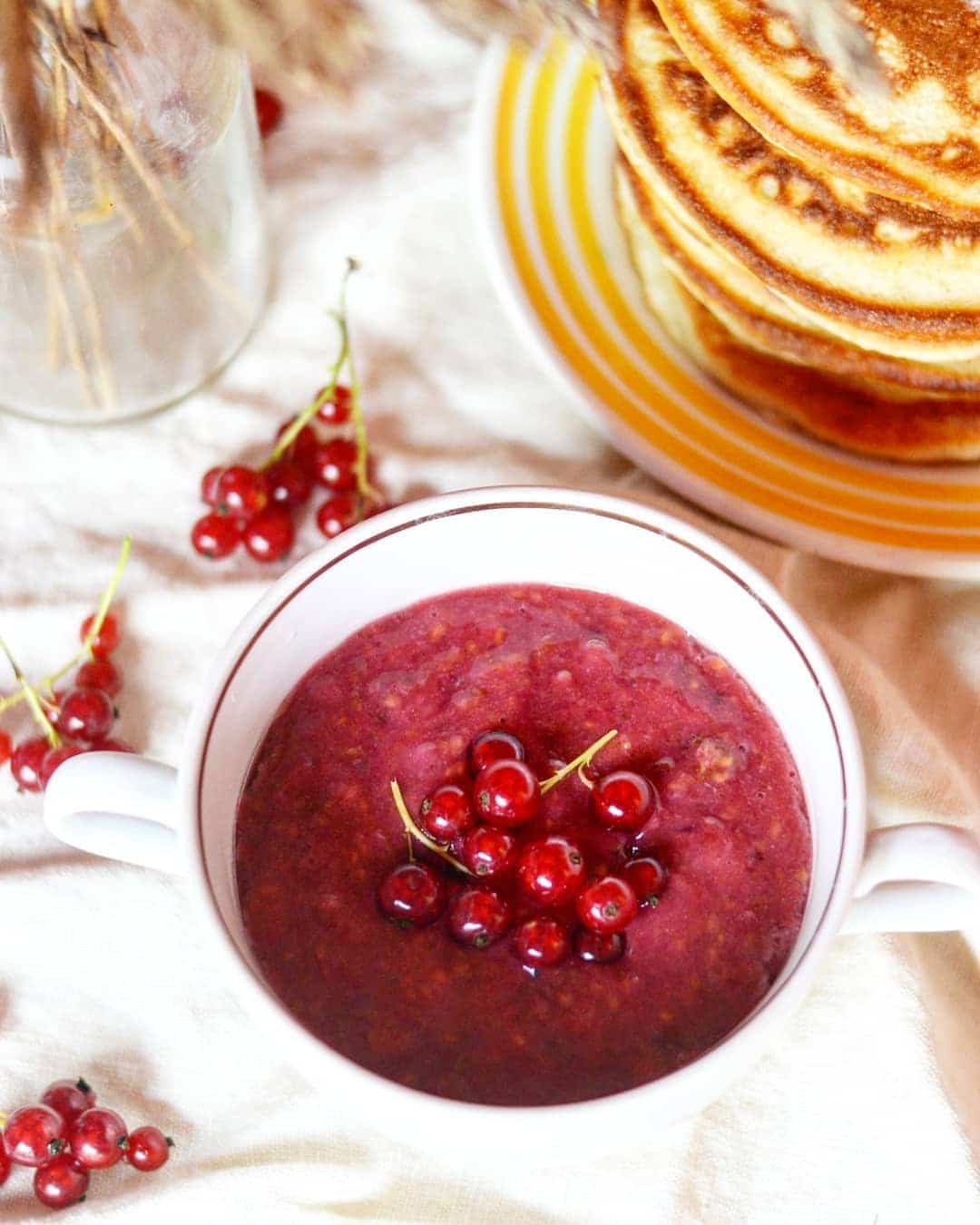
Belarusian kulaga can be made with any number of soft fruits available in the country: blueberries, blackberries, raspberries, cherries or plums. These are cooked gently, and traditionally eaten with honey and quark.
7. Belgium: Chocolate Mousse

The French may be credited with inventing chocolate mousse in the 1930s, but there’s no doubt that the Belgians – chocolate makers supreme – took it to a whole different level.
It is now known and loved the world over and makes a perfect ending to any meal. Light and airy yet rich and creamy at the same time, it melts in the mouth.
However, even the Belgians don’t take their love for this iconic dessert to the extent that they do in the USA, where they celebrate National Chocolate Mousse Day every April 3rd. Why not make your own and celebrate in style!
8. Bosnia and Herzegovina: Jabukovača

Jabukovača originates from the city of Sarajevo. It’s a luscious combination of apple pie and baklava.
Chopped apples, sugar, vanilla, walnuts, and lemon juice are spread over the thinly rolled dough. To serve, jabukovača is served sliced and covered with a sherbet made from a mixture of honey, sugar, and lemon juice. Mouthwateringly irresistible!
9. Bulgaria: Tikvenik

This wonderful traditional pumpkin strudel is one of Bulgaria’s favorite desserts. An irresistible combination of pumpkin, walnuts, and sweet spices, closed inside the crispest phyllo pastry (made with butter, of course). Simple, and irresistible.
10. Croatia: Makovnjača

Makovnjača is a fragrant Croatian take on the ubiquitous poppy seed roll. The dough is filled with sugar, cinnamon, and poppy seeds, which are placed in boiling milk and stirred before spreading.
Served sliced, it’s most popular as a special Christmas and Easter treat.
11. Czech Republic: Kolache

The name kolache comes from the Czech word, kola, which means wheels or rounds. Kolaches are traditionally made in Czech homes from sweetened yeast dough filled with fresh fruit.
They’re served as an afternoon snack or even as a delectable treat at weddings and other celebrations. In addition to poppy seeds, apricot, prune, and cherry compotes are all commonly used fillings.
12. Denmark: Æblekage

Æblekage, aka Danish Apple Cake isn’t strictly speaking a cake. But who cares? It’s more like a trifle in texture, though without cake or custard!
It becomes more solid when chilled. Some versions use breadcrumbs, oats, or crumbled macaroons, served in bowls to be scooped up with a spoon and enjoyed with afternoon coffee.
13. Estonia: Kohuke

This delicious snack tends to be more shop-bought than homemade. Kohuke is prepared with pressed sweet curd cheese (quark) and covered in chocolate.
You’ll find variations to suit every palate: vanilla, chocolate, or caramel. For decoration fruits, flaked coconut, or poppy seeds add interest.
14. Finland: Salmiakki

Salty black licorice is one of those flavors, like aniseed and whiskey, that people either love or hate. But there’s no doubt that it’s an iconic Finnish flavoring.
And although most salty licorice is shop-bought, it can be made at home and offered on special occasions such as parties. It’s a combination of brown rice syrup and molasses, for sweetness and color, and is not difficult to make.
15. France: Crème Brûlée

Crème brûlée is an elegant, creamy French dessert served in small individual dishes.
It’s basically a custard made with cream, sugar, and egg yolks, which are gently cooked in a water bath until set. The top is sprinkled with granulated sugar, and then – the drama begins, as it is caramelized with a blow torch until it turns a sumptuous golden brown.
To eat crème brûlée, you crack through the glassy cover, and scoop up the creamy custard. It is sometimes served with fresh berries.
16. Georgia: Churchkhela

Georgia is known for its amazing wine, so it’s no surprise that grapes and wine are the main ingredients in most traditional Georgian desserts.
The first and favorite snack of all the Georgians is churchkhela, a candle-shaped candy made from nuts and grape juice (madagi). Churchkhela is a delicious and nutritious dessert.
17. Germany: Black Forest Cake

Known and loved around the world, traditional Black Forest Cake makes a perfect dessert for all types of celebration meals. The light texture of three layers of chocolate sponge is enhanced with the rich cream filling and whole cherry topping.
The sides are decorated with chocolate shavings and more decadent versions are soaked in Kirsch liqueur.
18. Greece: Galaktoboureko

Galaktoboureko is a golden and delectable traditional Greek dessert, similar to baklava. Layers of crisp phyllo pastry, dotted with melted butter, filled with the creamiest semolina custard, are then drenched in lusciously scented syrup.
Traditionally they’re served at weddings and other feasts, but these days they’re often found as a luscious afternoon treat. They’re sometimes served hot in winter, cold in summer – when connoisseurs believe they’re at their best.
Press a piece with your spoon to cut it, and watch the sweet juice cascade out from the pastry. Who could resist such a mouth-watering treat?
19. Holy See: Cannoli

Although they originated in Sicily, Cannoli, or little tubes, are one of the most popular desserts in Vatican City.
A cannolo is a tube of fried pastry, stuffed with sweet ricotta cheese and candied fruits, and sprinkled with powdered sugar on top. The experience of the first bite is unique, and the taste is unforgettable.
20. Hungary: Dobos Cake

This iconic Hungarian cake is made from seven thin layers of sponge, separated by thick chocolate buttercream.
It’s then topped with caramel and may be finished with ground nuts or chestnuts. This is an elegant confection, which makes a perfect centerpiece on special occasions.
22. Iceland: Skyr

This traditional Icelandic yogurt rewards the patience you’ll need to make your own. It’s naturally far less sweet than commercial American yogurts, so enjoy it with sweetened berries or fruit compote, honey, or maple syrup.
23. Ireland: Irish Apple Cake

This authentic Irish apple recipe would be made during the apple harvest season and into the winter. Each family, of course, has its secret variation.
It’s usually subtly spiced, and the thin slices of tart apples are traditionally topped with an oat-based crumble. It can be served alone but is made even more scrumptious with hot custard sauce or a dollop of thick cream.
24. Italy: Tiramisu
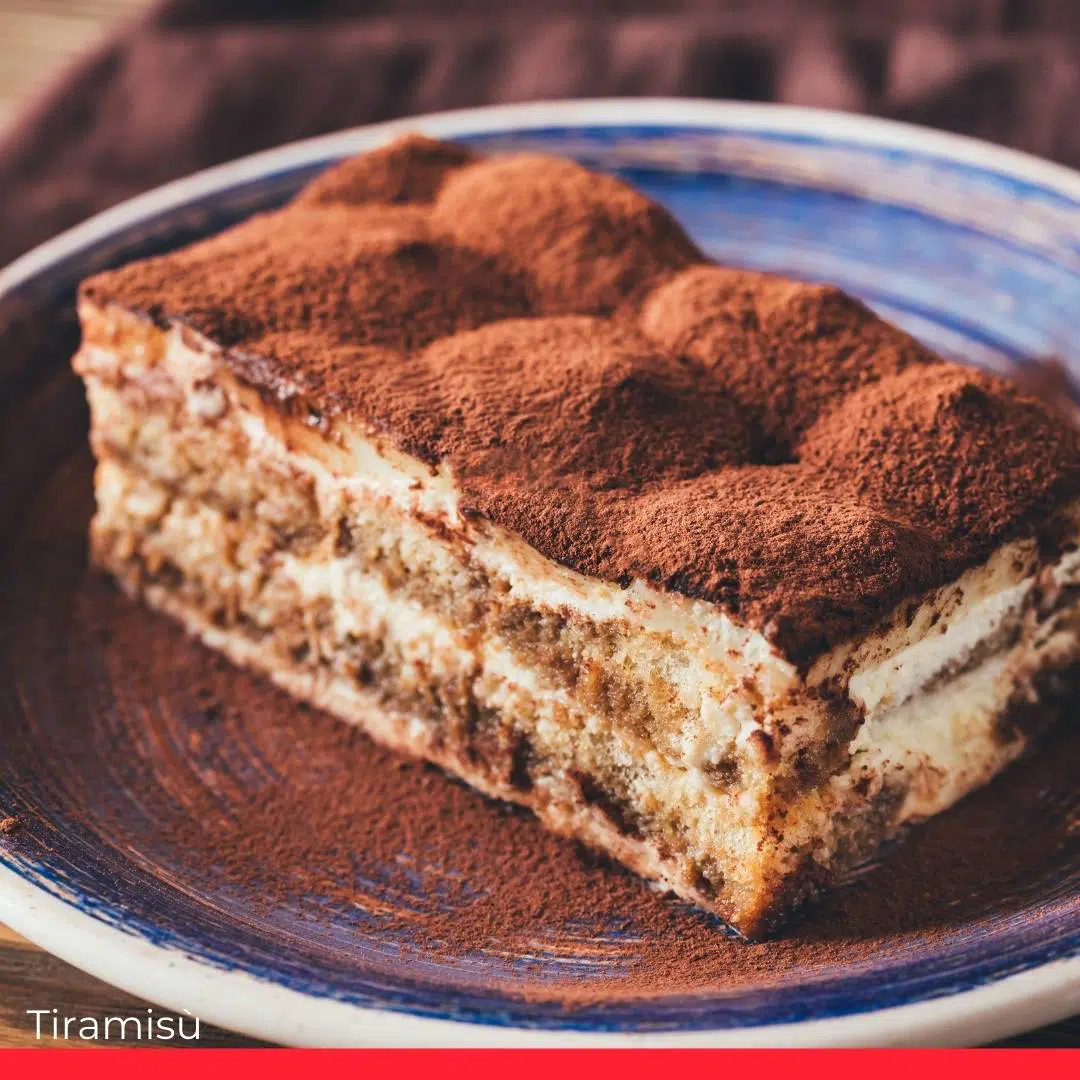
Italy’s most famous dessert originated in Treviso, near Venice. It’s a delicious and intriguing combination of savoiardi ladyfingers (light sponge), mascarpone, and sugar all soaked through with espresso.
It’s the kick from the coffee that earned it its name, which, translated, means ‘pull me up’. Tiramisu can be quite dry or sloppy, and needless to say, from the most famous chef to the most humble family cook, every recipe is the most authentic!
25. Kosovo : Baklava

One of the most treasured desserts in the Balkans, baklava is a favorite treat in Kosovo too.
26. Latvia: Maizes Zupa

Latvia’s signature dessert is a clever way to use up rye bread simply by adding spices such as cloves and cinnamon, as well as dried fruits. The thick, sweet dessert is served cold, accompanied by thick cream.
27. Liechtenstein: Ribel
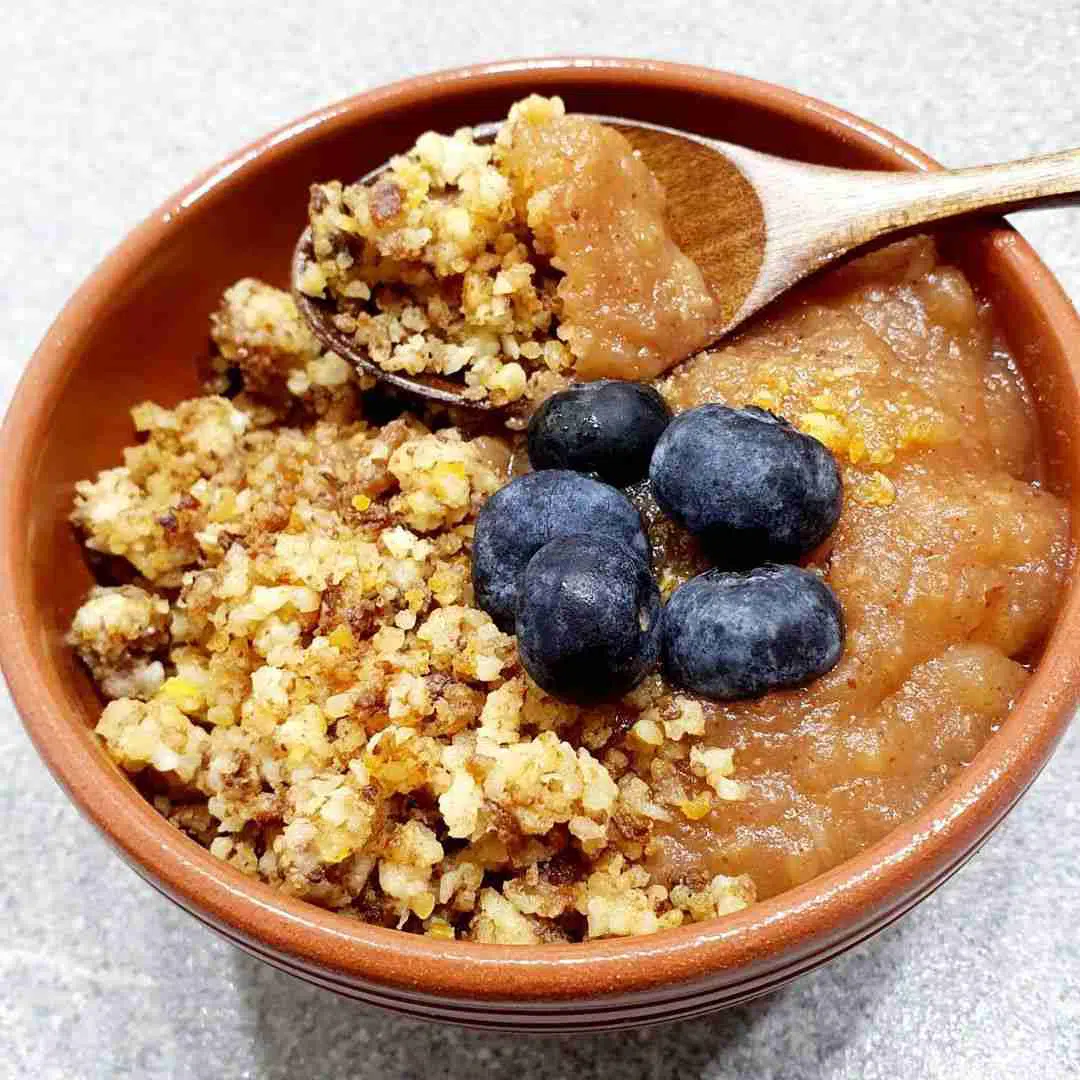
This cornmeal-based dish was a staple of the poor in times past. Today, ribel can be served with fruit compote, apple sauce, cooked cherries, or local elderberry sauce. Delicious and comforting during cold winter evenings.
28. Lithuania: Tinginys

If you’ve been reading through this list of treats in search of one that’s no-bake and incredibly easy to make, you can stop your search right now!
Tinginys can be roughly translated as lazy man because so little effort is required. They’re a combination of crumbled biscuit, condensed milk, butter, and cocoa, with some cherries added for good measure. Mix everything and chill. Then enjoy in whatever way you prefer!
29. Luxembourg: Quetschentaart
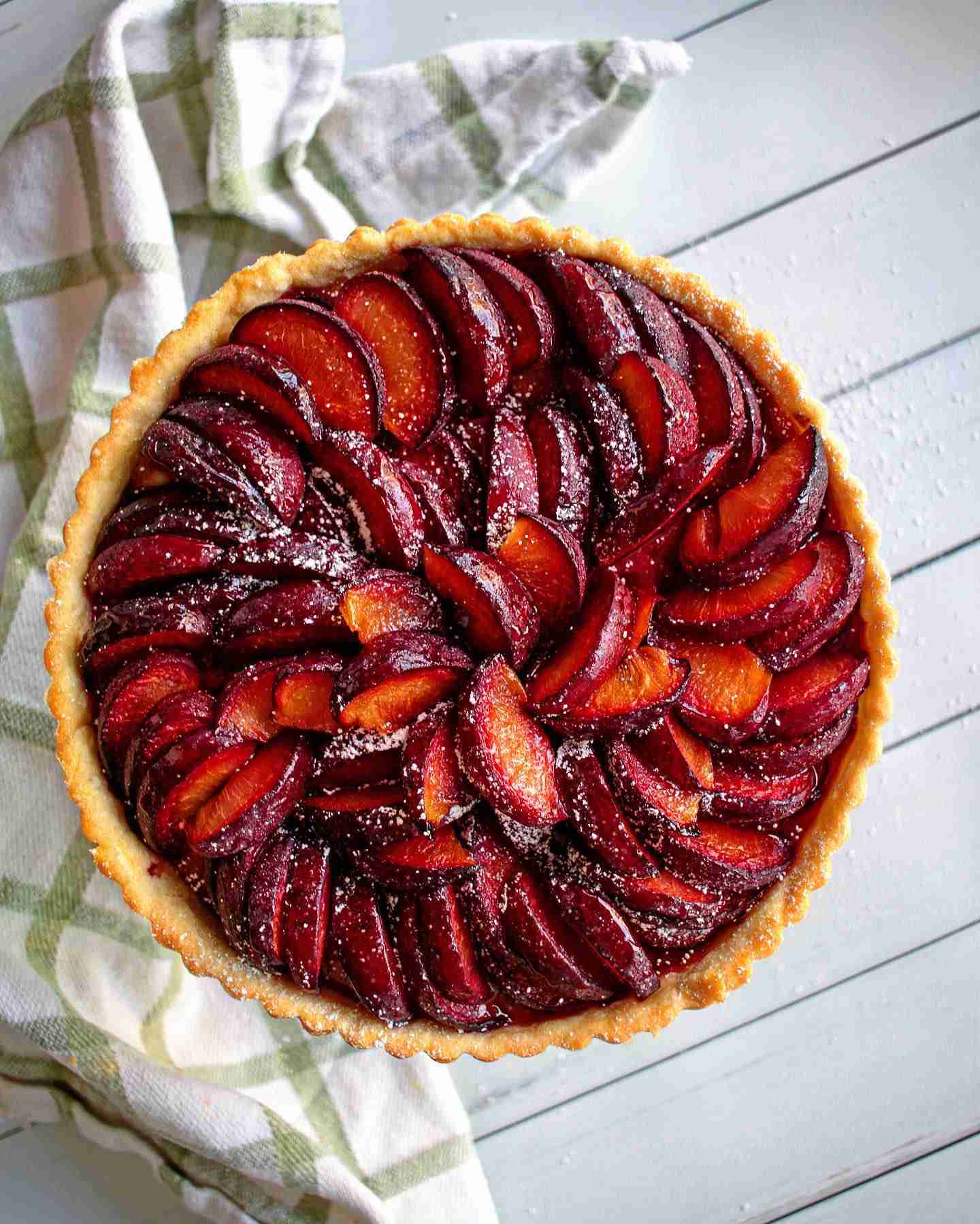
How yummy! This simple damson tart is a traditional Luxemburgish treat enjoyed in the closing months of the year. Found in bakeries as well as prepared in home kitchens, it’s perfect served with clotted cream or custard.
30. Malta: Imqaret

Imqaret have their roots in Arab culture. Diamond-shaped bites of dates, citrus, and spices are enclosed in pastry and deep-fried or baked.
A festive favorite in Malta, these can be bought from the numerous stalls which make fresh batches to be enjoyed by hungry passers-by, attracted by the delicious aroma.
31. Moldova: Baba Neagră

Baba Neagră, which is literally translated to black granny cake, almost defies description. It’s not exactly a cake, it’s not gingerbread, it’s not a biscuit. It’s just a magical concoction – not too sweet and with a firm texture.
The traditional end to every festive Moldovan meal, it’s baked, often in several batches for large gatherings, at a low temperature for up to 6 hours. This accounts for the unforgettable caramel flavor.
It’s also a typical companion for another Moldovan classic – White Grandmother or sweet noodle pudding, which is a whole other story!
32. Monaco: The Galapian

This glamorous dessert fits perfectly with the glitzy jet-set image of Monaco. It’s quite recent to be considered traditional as it was invented in 1994, but it’s a firm favorite at parties, especially when accompanied by a glass or two of sweet muscat.
Galapian is a unique concoction: slices of sweetened cantaloupe wrapped in an airy almond cake, then decorated with glistening maraschino cherries and lavender honey.
33. Montenegro: Heljdija

As buckwheat isn’t a grain (it’s a seed), these layered pancake treats are ideal for those on a gluten-free diet. They can have any number of fillings, sweet or savory.
Preparing and filling the pancakes is quite time-consuming, so, in the past, they tended to be kept for saints days and other special occasions. Nowadays this delicious specialty can be enjoyed year-round!
34. Netherlands: Dutch Stroopwafel

According to legend, Stroopwafels originated in the city of Gouda sometime in the late 18th century, when bakers found a novel way to reuse scraps and crumbs by pressing them and sweetening them with syrup.
Today they’re made with two thin layers of pressed dough with a luscious caramel filling – a mixture of molasses, brown sugar, and cinnamon.
They’re usually eaten warm, but if they’re cold, stroopwafels are sometimes placed on top of a cup of hot coffee to warm them and soften the delectable syrupy center. It’s a must-try dessert when visiting the Netherlands.
35. North Macedonia: Baklava

With its roots in the Ottoman Empire, baklava is now internationally known and loved.
It’s also one of the best-loved desserts in the Balkans, including North Macedonia. The rich flaky pastry is layered with chopped walnuts before being drenched in sweet syrup. Irresistible.
36. Norway: Kransekake

This show-stopping wreath cake is the undisputed signature cake of Norway and makes a perfect centerpiece for special occasions.
Constructed from eighteen thin rings of cookies, it is held together with a mixture of almonds, sugar, and egg whites. The cookie tower is held in place with royal icing. Cut with care – then enjoy!
37. Poland: Sernik

This mouthwatering baked cheesecake is known as the Queen of Polish desserts.
It was traditionally reserved for special occasions such as Christmas and Easter but is surprisingly easy to make. You just need some farmer’s cheese, a few eggs, and a few additions such as cream and vanilla.
38. Portugal: Pastel de Nata

An irresistible combo of caramelized custard and flaky golden-brown pastry, pastel de nata is Portugal’s favorite dessert.
The recipe for these typical custard treats hails from the town of Belém, near Lisbon, where monks in the Jerónimos Monastery, devised these little pies.
They look like little nests, filled with custard, caramelized on top. The story is that the monks, who used egg whites as clothing starch, wanted to find a way to use up the yolks. These pastries were the result of their creativity.
39. Romania: Cozonac

Cozonac is famous as a classic, simple, sweetened yeast bread which originated in Romania.
Traditionally made to enjoy during Easter and Christmas, it’s a spiral of sweet, lemon-scented sweet dough with a nut filling. The result is a delectable festive loaf bread with a soft, crumbly texture.
40. Russia: Napoleon Cake

Napoleon cake is one of several contenders for the title of National Desert of Russia. But this wonderful confection, created from as many as 16 crispy pastry layers, and filled with sweet, creamy custard, is for many people, the clear winner. It’s a kind of mega mille-feuille.
Every baker will have their variation – some recipes call for only 10 layers, which is a little less time-consuming to make and perhaps a little easier to eat!
41. San Marino: Torta Tre Monti

This popular cake from tiny San Marino is named after its famous peaks. It’s built from delicately layered wafers filled with hazelnut spread and cream.
That’s not all! It’s glazed with chocolate icing and often served with a topping of dark chocolate ice cream. To finish, add a cherry on top. Who could resist?
42. Serbia: Vasina Torta

Vasina torta is a famous authentically Serbian cake served at birthdays and winter celebrations. It’s a citrus-tinged sponge with a luscious creamy walnut filling and then topped with a crumbly icy-white meringue.
A delectable combination of contrasting flavors and textures which dates back almost a hundred years.
43. Slovakia: Šišky

Traditionally made and eaten between Three Kings (January 6th) and Ash Wednesday, these sweet breakfast doughnuts have a heritage that’s linked to folk tales and has deep roots in the culture of Slovakia. The fried dough is filled and topped with strawberry jam.
44. Slovenia: Poteca

Poteca is a traditional nutty roll. It’s made with a yeast-based pastry that is layered with a sweet filling of pecans and brown sugar. Although it’s time-consuming to prepare (baking for 3 hours), it’s a much-loved part of any Slovenian Christmas feast.
45. Spain: Crema Catalana

Crema Catalana resembles France’s crème brûlée, except that it’s made with milk rather than cream.
In modern recipes, cornflour is sometimes added, as well as flavorings such as lemon zest, cinnamon, and vanilla. Like crème brûlée, crema Catalana is topped with a glass crust of caramelized sugar which covers the creamy delight waiting below.
46. Sweden: Prinsesstårta

This classic Swedish cake is made from a layered sponge, raspberry jam, vanilla custard, and whipped cream. It is usually covered with green marzipan, and shaped like a dome.
The fourth week in September is officially Princess cake week when every prinsesstårta sold is topped with a gold crown as part of a charity fund-raising effort.
Fun fact: these cakes were devised and named in honor of three nieces of King Gustav V by their home economics instructor.
47. Switzerland: Brunsli

From the land that’s synonymous with fine chocolate come brunsli – classic Christmas biscuits made from nuts, chocolate, and spices with a dash of kirsch to give them a grown-up cherry note.
As a final touch, the dough is covered with caster sugar, which gives the outside a wonderful crunchy ‘bite’ to contrast with the soft interior.
48. Türkiye: Baklava
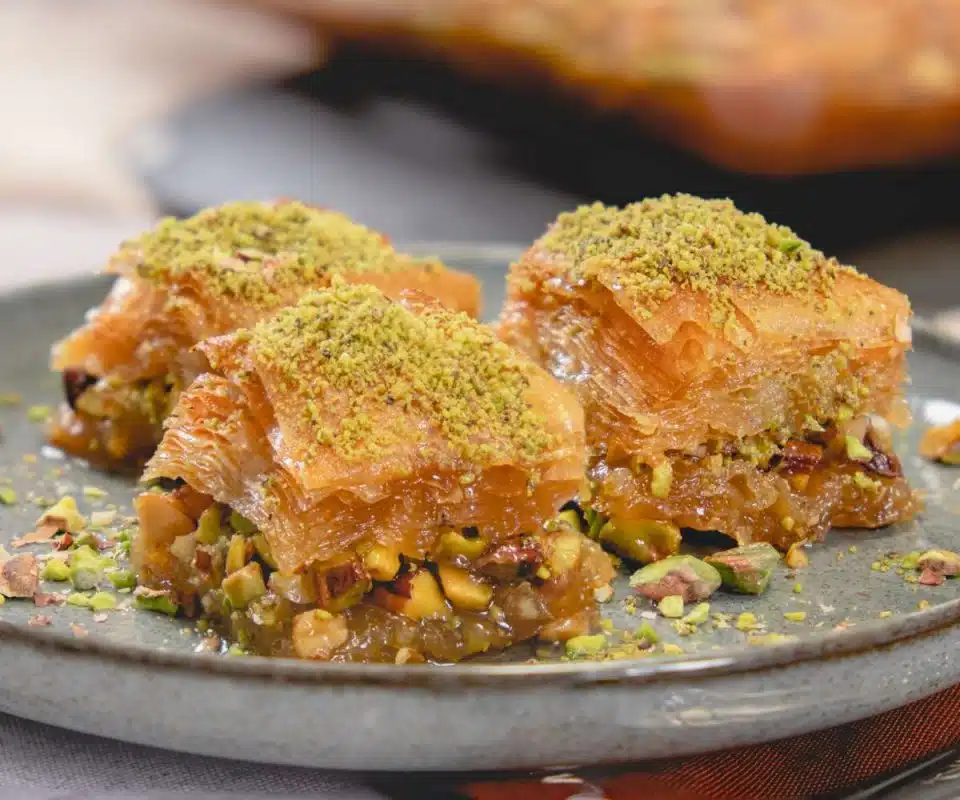
Baklava is a delicious, sweet pastry made with layers of phyllo dough, nuts, and syrup. It is a popular dessert in many Middle Eastern and Mediterranean countries and has a long history dating back to the Ottoman Empire.
Check out this delicious Turkish baklava recipe by Chef Feyza Kirmaci.
49. Ukraine: Vareniki

These traditional Ukrainian treats are crescent-shaped pastries, around 10cm long. Although they’re sometimes compared to Russian pelmeni or Italian ravioli, they’re made from a dough that may also include kefir and eggs.
Although savory versions also exist, vareniki are often filled with soft fruits such as strawberries or cherries and powdered sugar. When filled, they’re boiled for 5 mins. They’re usually served with a dollop of thick sour cream.
50. United Kingdom: Trifle

Trifle has been a favorite in the UK for more than 300 years. Traditionally, it’s made with layers of sponge fingers (which can be soaked in sherry to give the dish a more ‘grown up’ feel), fresh custard, jelly, whipped cream, and berries. (Kids tend to prefer a topping of sprinkles).
Trifle is a guaranteed crowd-pleaser which allows each cook plenty of opportunities to add their own twist.
Related: National Dishes of Europe, Mapped

The post Mapped: National Desserts of Europe appeared first on Chef's Pencil.
from Chef's Pencil https://ift.tt/02AyQto
via https://chefsspenncil.blogspot.com

No comments:
Post a Comment